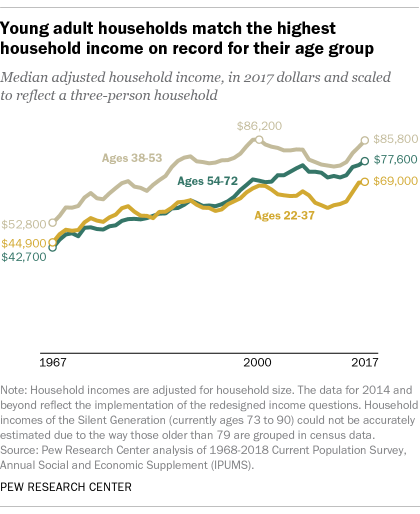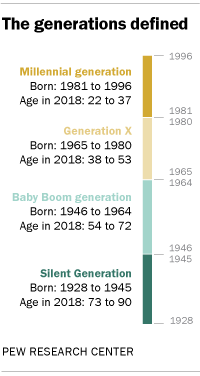After bottoming out in 2011, incomes are rising for American households – and those headed by a Millennial (someone age 22 to 37) now earn more than young adult households did at nearly any time in the past 50 years, according to a Pew Research Center analysis of new census data.

The growth in household incomes among young adults has been driven in part by Millennial women, who are working more – and being paid more – than young women were in previous years.
Incomes of households headed by 54- to 72-year-olds, Baby Boomers today, are at record levels, while those of current Generation X households (ages 38 to 53) are about the same as the peak earnings of similarly aged households in the past.
The median adjusted income in a household headed by a Millennial was $69,000 in 2017. That is a higher figure than for nearly every other year on record, apart from around 2000, when households headed by people ages 22 to 37 earned about the same amount – $67,600 in inflation-adjusted dollars. (A recent study by the Federal Reserve, which also looked at Millennials’ income, used a different methodology and data source.)
Among Baby Boomers, the typical household income was $77,600 in 2017, outpacing the previous record for households in the 54-to-72 age group ($75,800 in 2007). The typical income of a household headed by a Generation Xer was $85,800, approximating the peak for this age group in 2000 ($86,200). (Members of the Silent Generation are currently ages 73 to 90, but the income of households in this age group cannot be accurately estimated.)
How have Millennial households generated their comparatively high earnings? At least two factors related to women in households headed by Millennials are buttressing their income.

Women in Millennial households worked more in 2017 than their counterparts in young adult households did in 2000. Among those who were employed, 78% of women in Millennial households in 2017 worked at least 50 weeks of the year. In 2000, by comparison, 72% of women workers in households headed by 22- to 37-year-olds worked as long.
Aside from working more, women in young adult households are being paid more. The median earnings of women working full time for a full year (in households headed by people ages 22 to 37) rose from $37,100 in 2000 to $39,000 in 2017.
Millennial households have obtained these higher incomes even though the households are somewhat less likely to have two contributing spouses or partners. Today, 55% of young adult heads of a household have a spouse or cohabiting partner, down from 57% in 2000. The share of young adult households with two earners fell from 49% in 2000 to 44% in 2017.
